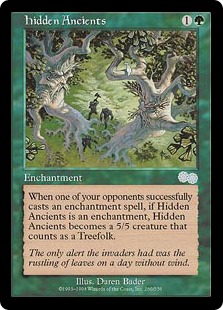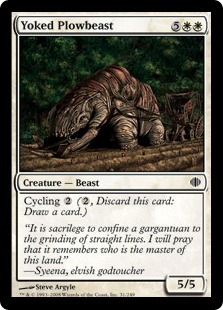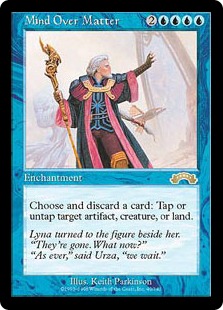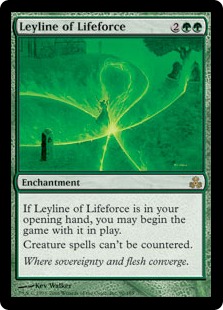
[B]GAMES ESOTERICA[/B]
by Stefan Lindberg

Keep an eye out for hidden ancients!
So what does this have to do with [b]Magic: the Gathering[/b]? From the perspective of game theory, Karate and [b]Magic[/b] are both games in that they are governed by sets of rules and depend on anticipating the opponent's moves. But more importantly, you could also consider the games of [b]Magic[/b] that you've played to be “painted fences” and “waxed cars” that have primed you for key insights of our time. Most [b]Magic[/b] players don't realize that mastering the most complicated game on the planet has put them in a unique position to understand scientific, philosophical and even spiritual principles that are not readily available to the uninformed public. And this untapped potential has been bestowed on you for free, while playing! In Mr. Miyagi's own words: “Lesson not just karate only. Lesson for whole life.”
With that, I'd like to welcome you to this monthly column! Gathering the Magic will look at our favorite card game from a philosophical perspective, and point out analogies with the real world, to make the reader more fulfilled – both as a player and as a person. You will not find any discussion of card choices, rules conundrums or tournaments here, but we may very well cover analytical principles or generic strategies that will serve you both in the game and outside of it. The game of [b]Magic[/b] will serve as our springboard of analogies as we jump into contemporary subjects in diverse fields!

The yogi is concerned with straight lines.
In this first article, we'll take a closer look at the concept of games esoterica – that is, the basic premise of this column, that games contain hidden information that is not readily apparent unless you approach them with a certain mindset. Let us begin with one of the most prestigious games in the western world: Chess.
As you know, Chess is played on a checkered board of 8x8 squares. In fact, the appearance of the board is so intimately linked with the game that we derive the adjective “checkered” from its name. “Chess” itself comes from Persian “shah” (meaning king), but the game actually originated in India around the 6th century. The idea behind Chess is to simulate warfare, and as such served as a valuable teaching instrument for the Kshatriyas – the Indian warrior caste. Most likely, the game was developed with help from the Brahmin caste, the scholars, teachers and priests of ancient India. What can we unveil of their ancient wisdom?
The name for king in sanskrit is rayan (known perhaps from “maharaja” - great king). It's not a far cry from English “royal”, derived from latin regere: to keep straight or rule. Thus, a “ruler” is both a political figure as well as an instrument for drawing straight lines or rays (cf. rayan, royal). So Chess, the game of kings, is a game of rays and straight lines, which sums up the movement of the various pieces rather nicely. Apart from being an exercise at war, it is a raja yoga or “king's yoke”. A yoke, of course, is an item forming a unity between things that carry great weight, things you need to take with you on your journey. The Raya Yoga (one of the traditional schools of Hindu philosophy), is so named because it is a yoga that deals with the mind – considered the “king” of the multi-layered structure that does its bidding. The sanskrit sutra begins with the statement “yogas citta vritti nirodha” freely translated as “the goal of yoga is to limit the writhing of the mind.” And as we shall see, therein lies the higher purpose of the Chess game as well.

Waiting - the key to focus.
Teachings for warriors must inevitably concern themselves with the mind. Such is the case with Chess, Karate, other budo systems, martial arts in general - all the way down to sports and games in general. From the natural impulse to play - be it Chess or a game of [b]Magic[/b] - we can derive two very different principles for mental training: concentration and focus. If we turn play into competition, we practice concentration or the Yang side of play. This includes rapid decision making, being smarter or quicker than someone else, and quite simply winning. If we turn turn play into contemplation, we practice focus or the Yin side of play. This includes realizing and reflecting, being smart as such, or simply being. Both are yogas that still the writhing of the mind, but in quite different ways.
When you are concentrating on something, you become absorbed by it - there is nothing going on in your mind except that game you are playing. When the game stops, the mental writhing returns. The more you play, the more you learn to plunge into the task at hand, shut everything else out and do your thing. On the other hand, when you focus on something, it becomes absorbed by you. Your are not in a hurry, you simply allow the subject matter to inform you of itself. The mind may writhe as it will meanwhile, but you pay no attention to it. For example, you can contemplate in which cases the knight is superior to the bishop, and what this teaches you about some aspect of the real world - perhaps warfare. Just as well, you may focus your mind on the rock-paper-scissors nature of [b]Magic[/b] (aggro-combo-control) and what this tells us about evolutionary principles (something we'll revisit later). The more you practice this yoga, the more proficient you become at unveiling the epiphanies that lie just beneath the surface, normally lost in the white noise of the mind.
Dear reader, the yoke's on me! My mission is to take you on a [b]Magic[/b] journey in a direction opposite to the one the Chess game has made historically. A modern game of Chess is hardly considered a battlefield simulation, nor a contemplative exercise (but there's no reason it couldn't be, even today). Like other games before it, it has become a pastime and sport in its own right (the first modern chess tournament was held in 1851). And while we may lament the forgotten wisdom encoded in it, we should simultaneously praise its entertainment value, for it is this latter trait that has ensured its survival – and with it, the gateway to the timeless wisdom of the ancient warrior caste.

Notice the symbols on the wheel!
[b]Magic: the Gathering[/b] is the gateway to timeless wisdom for the new warrior caste - the players and gamers of the world. It developed as pastime, became competitive sport, and now the time has come to explore its philosophical depths. When Richard Garfield created the game for WotC in 1993, he invented the genre of collectible card games, combining three ideas into one: the idea of a card game known from simple playing cards, the idea of collectible cards known for example from the world of baseball, and the idea of an appealing fantasy theme (today there are of course similar games with other themes to them). Playing cards have an ancient history and probably originated in Asia, but [b]Magic[/b] actually has more in common with a particular set of playing cards featuring allegorical illustrations: the Tarot.
What sets the Tarot deck apart from regular playing cards is primarily its 22 trumps constituting the Major Arcana or “main mysteries”. These iconic portraits found themselves being put into playing cards at some point during the Middle Ages – another example of the “gameification” of wisdom. The Arcana represent archetypes of the same kind that C.G. Jung makes mention of; ideas and personae that humanity can identify with and learn from, such as The High Priestess, The Wheel of Fortune or Judgement. The common idea that Tarot cards are an instrument for divination is yet another example of how the original purpose of the material has degenerated into something less essential but more entertaining and profitable. In fact, it wasn't until the 18th century that charlatans began using the cards for divinatory purposes.
Now, if the Tarot is a melting pot for human learning, surely b]Magic[/b] is a bouillabaisse, boasting a card pool of several thousand cards, most of which carry stunning art work. Add to this the most complex set of rules any game has ever seen, and it should become apparent that we have a system at our disposal that can teach us a great deal. For an example of this, I'd like to point you to this Legacy Merfolk primer. To help explain the deck, the author used a baseball analogy throughout the primer. The problem is, I'm a Swede and we don't play or even watch baseball like you Americans do. So the baseball analogy didn't help me get a better grasp on Merfolk, but since I already understood the deck fairly well, the primer did help me understand some basic concepts of professional league baseball instead! Much like that primer, and much like Tarot, this column will use the power of analogy and contemplation to illustrate complex phenomena. Where the goal of this article is simply to introduce the concept and point to the mental faculty of focus needed to realize it, later articles will be concerned with specifics.

Life: a source of complex patterns.
And so we have arrived at the end of the beginning of this column, and the beginning of the end of this article. But an overview of games esoterica would hardly be complete without mentioning, in parallel to Chess, Tarot and [b]Magic[/b], one of the oldest games known to man: Go. Developed more than 2,500 years ago in East Asia, Go probably served the same role as Chess – to still the mind, educate the warrior class and train strategic thinking suitable for warfare. But the Go system would in fact prove so general as to have much broader applications than that. In 1970, mathematician John Conway invented what he called The Game of Life using the simple black and white stones of the Go board. Conway's “Life” constitutes what is known as a cellular automaton - a part mathematical, part graphic way to illustrate change and evolution. Go, Life, and some elements of M:tG are all examples of something called complexity – a scientific heir of sorts to the field of chaos theory.
Complexity theory can be used to explain how elaborate patterns can emerge from very simple rules, or how very simple rules can emerge from elaborate patterns. For example, how can relatively simple organisms such as ants build complex structures such as an anthill complete with nursery and livestock? Examining the ant, even in great detail, will not reveal the answer! Looking from the other end, even if you look at the myriad of steps required to obtain coffee, it is still hard to justify the price of a single cup. Whatever it is that's keeping the price up, we can't expect to affect it greatly by increasing or lowering the cost for a certain manufacturing step. And even so, workers in the field get payed very little. How is this possible?
In my next article, we'll learn more about complexity and its applications by taking a closer look at how thousands of cards combine to three basic archetypes - aggro, combo and control - and how three simple building blocks like that go on to create diverse and ever-changing meta games. We'll also look into evolutionary principles and anthills, the price of coffee, and why political decisions can't change political problems.
Comments